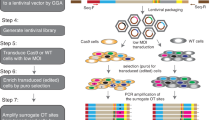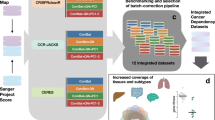Abstract
High-throughput, human cell-based applications of RNA-mediated interference (RNAi) have emerged in recent years as perhaps the most powerful of a ‘second wave’ of functional genomics technologies. The available reagents and methodologies for RNAi screening studies now enable a wide range of different scopes and scales of investigation, from single-parameter assays applied to focused subsets of genes, to comprehensive genome-wide surveys based on rich, multiparameter readouts. As such, RNAi-based screens are offering important new avenues for the discovery and validation of novel therapeutic targets for several disease areas, including oncology. By enabling a ‘clean’ determination of gene function, that is the creation of direct causal links between gene and phenotype in human cells, RNAi investigations promise levels of pathophysiological relevance, efficiency, and range of applicability never before possible on this scale. The field of oncology, with its many assays using readily transfectable cell lines, has offered particularly fertile ground for showcasing the potential of RNAi-based genomics. However, like any other technology before it, RNAi is not without its own challenges, limitations, and caveats. Many of these issues stem directly from the choice of silencing reagent to be used in such studies, and the design of the overall screening strategy. Here, we discuss the basic design issues, potential advantages, and technical challenges of large-scale RNAi screens based on the use of chemically synthesized siRNA libraries.
This is a preview of subscription content, access via your institution
Access options
Subscribe to this journal
Receive 50 print issues and online access
$259.00 per year
only $5.18 per issue
Buy this article
- Purchase on Springer Link
- Instant access to full article PDF
Prices may be subject to local taxes which are calculated during checkout

Similar content being viewed by others
References
Arts GJ, Langemeijer E, Tissingh R, Ma L, Pavliska H, Dokic K, Dooijes R, Mesic E, Clasen R, Michiels F, van der Schueren J, Lambrecht M, Herman S, Brys R, Thys K, Hoffmann M, Tomme P and Van Es H. (2003). Genome Res., 13, 2325–2332.
Berns K, Hijmans EM, Mullenders J, Brummelkamp TR, Velds A, Heimerikx M, Kerkhoven RM, Madiredjo M, Nijkamp W, Weigelt B, Agami R, Ge W, Cavet G, Linsley PS, Beijersbergen RL and Bernards R. . (2004). Nature, 428, 431–437.
Carpenter AE and Sabatini DM . (2004). Nat. Rev. Genet., 5, 11–22.
Clemens JC, Worby CA, Simonson Leff N, Muda M, Maehama T, Hemmings BA and Dixon JE . (2000). Proc. Natl. Acad. Sci., USA, 97, 6499–6503.
Elbashir SM, Harborth J, Lendeckel W, Yalcin A, Weber K and Tuschl T . (2001a). Nature, 411, 494–498.
Elbashir SM, Martinez J, Patkaniowska A, Lendeckel W and Tuschl T . (2001b). EMBO J., 20, 6877–6888.
English JJ, Mueller E and Baulcombe DC . (1996). Plant Cell, 8, 179–188.
Fire A, Xu S, Montgomery MK, Kostas SA, Driver SE and Mello CC . (1998). Nature, 391, 806–811.
Fraser AG, Kamath RS, Zipperlen P, Martinez-Campos M, Sohrmann M and Ahringer J . (2000). Nature, 408, 325–330.
Gönczy P, Echeverri C, Oegema K, Coulson A, Jones SJ, Copley RR, Duperon J, Oegema J, Brehm M, Cassin E, Hannak E, Kirkham M, Pichler S, Flohrs K, Goessen A, Leidel S, Alleaume AM, Martin C, Ozlu N, Bork P and Hyman AA . (2000). Nature, 408, 331–336.
Hamilton AJ and Baulcombe DC . (1999). Science, 286, 950–952.
Holen T, Amarzguioui M, Wiiger MT, Babaie E and Prydz H . (2002). Nucleic Acids Res., 30, 1757–1766.
Hopkins AL and Groom CR . (2002). Nat. Rev. Drug Discov., 1, 727–730.
Hsieh AC, Bo R, Manola J, Vazquez F, Bare O, Khvorova A, Scaringe S and Sellers WR . (2004). Nucleic Acids Res., 32, 893–901.
Jackson AL, Bartz SR, Schelter J, Kobayashi SV, Burchard J, Mao M, Li B, Cavet G and Linsley PS . (2003). Nat. Biotechnol., 21, 635–637.
Kiger A, Baum B, Jones S, Jones M, Coulson A, Echeverri C and Perrimon NA . (2003). J. Biol., 2, 27.
Krönke A, Grabner A, Hannus M, Sachse C, Dorris D and Echeverri C . (2004). Drug Discov. World, 5, 53–62.
Lum L, Yao S, Mozer B, Rovescalli A, Von Kessler D, Nirenberg M and Beachy PA . (2003). Science, 299, 2039–2045.
Mueller E, Gilbert JE, Davenport G, Brigneti G and Baulcombe DC . (1995). Plant J., 7, 1001–1013.
Paddison PJ, Silva JM, Conklin DS, Schlabach M, Li M, Aruleba S, Balija V, O'Shaughnessy A, Gnoj L, Scobie K, Chang K, Westbrook T, Cleary M, Sachidanandam R, McCombie WR, Elledge SJ and Hannon GJ. (2004). Nature, 428, 427–431.
Persengiev SP, Zhu X and Green MR . (2004). RNA, 10, 12–18.
Reynolds A, Leake D, Boese Q, Scaringe S, Marshall WS and Khvorova A . (2004). Nat. Biotechnol., 22, 326–330.
Rubinson DA, Dillon CP, Kwiatkowski AV, Sievers C, Yang L, Kopinja J, Rooney DL, Ihrig MM, McManus MT, Gertler FB, Scott ML and Van Parijs L. (2003). Nat. Genet., 33, 401–406.
Sachse C, Krausz E, Krönke A, Hannus M, Walsh A, Grabner A, Ovcharenko D, Dorris D, Trudel C, Sönnichsen B and Echeverri C . (2004). Methods Enzymol, 392, (in press).
Scacheri PC, Rozenblatt-Rosen O, Caplen NJ, Wolfsberg TG, Umayam L, Lee JC, Hughes CM, Shanmugam KS, Bhattacharjee A, Meyerson M and Collins FS . (2004). Proc. Natl. Acad. Sci. USA, 101, 1892–1897.
Schwarz DS, Hutvagner G, Du T, Xu Z, Aronin N and Zamore PD . (2003). Cell, 115, 199–208.
Sledz CA, Holko M, de Veer MJ, Silverman RH and Williams BR . (2003). Nat. Cell. Biol., 5, 834–839.
Snove Jr O and Holen T . (2004). Biochem. Biophys. Res. Commun., 319, 256–263.
Sönnichsen B, Koski L, Walsh A, Marshall P, Neumann F, Brehm M, Alleaume A-M, Artelt J, Bettencourt P, Cassin E, Hewitson M, Holz C, Khan M, Lazik S, Martin C, Nitschke B, Ruer M, Stanford J, Winzi M, Heinkel R, Röder M, Finell J, Häntsch H, Jones S, Jones M, Coulson A, Oegema K, Gönczy P, Hyman AA and Echeverri CJ . Genome-wide screening by RNA interference identifies 663 genes required for the first cell division of C elegans. manuscript.
Xin H, Bernal A, Amato FA, Pinhasov A, Kauffman J, Brenneman DE, Derian CK, Andrade-Gordon P, Plata-Salaman CR and Ilyin SE . (2004). J. Biomol. Screen, 9, 286–293.
Yang D, Buchholz F, Huang Z, Goga A, Chen CY, Brodsky FM and Bishop JM . (2002). Proc. Natl. Acad. Sci. USA, 99, 9942–9947.
Zhang JH, Chung TDY and Oldenburg KR . (1999). J. Biomol. Screen, 4, 67–73.
Acknowledgements
We thank Andrea Krönke, Anne Grabner, Michael Hannus, Andrew Walsh, Liisa Koski, and Birte Sönnichsen for their scientific input, and Mary-Ann Grosse, Sindy Kluge, and Moddasar Khan for their skilled technical assistance. The work presented in this article has partially been supported by Grant no. 03I4002 of the German Federal Ministry of Education and Science (BMBF).
Author information
Authors and Affiliations
Corresponding author
Rights and permissions
About this article
Cite this article
Sachse, C., Echeverri, C. Oncology studies using siRNA libraries: the dawn of RNAi-based genomics. Oncogene 23, 8384–8391 (2004). https://doi.org/10.1038/sj.onc.1208072
Published:
Issue Date:
DOI: https://doi.org/10.1038/sj.onc.1208072
Keywords
This article is cited by
-
Use of CRISPR-based screens to identify mechanisms of chemotherapy resistance
Cancer Gene Therapy (2023)
-
Systems biology of cisplatin resistance: past, present and future
Cell Death & Disease (2014)
-
Comparative profiling identifies C13orf3 as a component of the Ska complex required for mammalian cell division
The EMBO Journal (2009)
-
RNAi and iTRAQ reagents united: targeted quantitation of siRNA-mediated protein silencing in human cells
Analytical and Bioanalytical Chemistry (2009)
-
PCR-based generation of shRNA libraries from cDNAs
BMC Biotechnology (2006)



